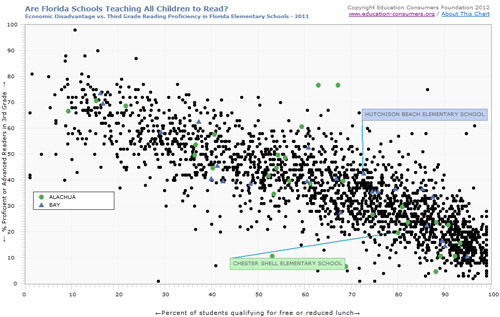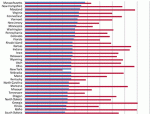Florida: Comparing schools and districts based on student proficiency
The information below reflects the most recent data available to us; please contact us with questions or to request additional analyses.

Analysis: Comparing schools and districts on third grade proficiency in reading and math
The charts linked below allow you to compare schools and districts in Florida with their peers. The Y (vertical) axis shows the percentage of proficient 3rd graders in a subject; the X (horizontal) axis shows the percentage of students who qualify for the free or reduced rate lunch program, a common indicator of poverty in schools.
Available charts:
- Poverty versus 3rd grade reading proficiency rates top two levels of proficiency (2022)
- Poverty versus 3rd grade reading proficiency rates top three levels of proficiency (2022)
- Poverty versus 3rd grade reading proficiency rates (2021)
- Poverty versus 3rd grade reading proficiency rates (2019)
- Poverty versus 3rd grade reading proficiency rates (2018)
- Poverty versus 3rd grade reading proficiency rates (2017)
- Poverty versus 3rd grade reading proficiency rates (2016)
- Poverty versus 3rd grade reading proficiency rates (2013)
- Poverty versus 3rd grade reading proficiency rates (2011)
Note: Compared to the scores reported by the National Assessment of Educational Progress (NAEP), the proficiency percentages reported by Florida as Level 3+ appear to be inflated. The independent NAEP reports 39% of the state’s 4th grade students to be proficient or above in reading. Florida is reporting 54% Level 3+ Proficient for 2022. In order to provide users more realistic estimates of local school performance, ECF has created two charts, one showing the percentage of students reaching the state’s “Level 3+” standard and another showing the percentage of students reaching the state’s “Level 2+” standard.
Note: Florida reports five levels of proficiency. The top two levels of proficiency, levels 4 and 5, were used to calculate proficiency.
Note: In the spring of 2015 Florida began using the Florida Standards Assessment. Previous year results should not be compared to the 2016 and subsequent assessments.
 Comparing Florida’s Proficiency Standards to the National “Gold Standard” (NAEP)
Comparing Florida’s Proficiency Standards to the National “Gold Standard” (NAEP)
Each state defines for itself what “proficient” means; some states have a rigorous definition, while others are less strict in their standards. To see how states compare, ECF has published charts showing the percentage of students deemed proficient in various subjects and grade levels and compared them to percentages reported for each state by the National Assessment of Educational Progress (NAEP, or “The Nation’s Report Card”), considered to be the gold standard.
